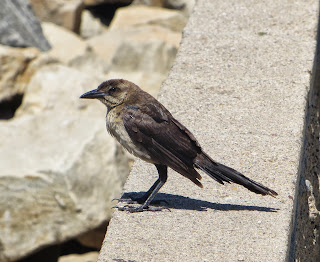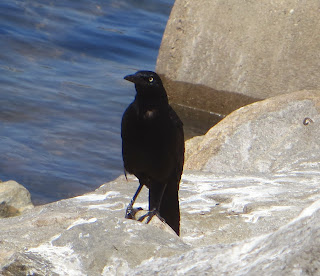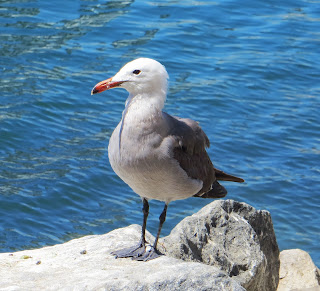I haven't posted in a long while because of computer problems. However, it's better now. I'll likely post more than usual this week, because of the birds in my yard and the bird count coming up this weekend. Next week I'll be going to Portland, Oregon with my mom and grandparents. I've never been there before, and I'll certainly be looking for birds.
Last week my grandparents took my brother and I to Carlsbad and Oceanside. We stopped by the beach to look for birds. The entire time we were there, brown pelicans were flying over. Brown pelicans are often in large flocks flying in V-formation. Below is a photo of three brown pelicans. Their flock was actually much larger, but too spread out to get in one photo. It's a bit hard to tell, but the two pelicans right next to each other are young ones. Young brown pelicans are plain brown above and white below. Adults have white, yellow, and red markings on their face and neck. The pelican in the bottom left corner of the photo is an adult.
 |
| Brown Pelicans |
There were also some Brewer's blackbirds, though not very many. Brewer's blackbirds summer in central southern Canada and northern central United States. They winter in the central southern United States and Mexico. They are found all year round in the western United States. They are very common and are often found in parking lots, farmland, and other open areas. Females are plain brown with dark eyes. Males are glossy black with pale eyes. They can be confused with great-tailed grackles, but they are much smaller with shorter tails and shorter, thinner beaks. Below is a male Brewer's blackbird in a parking lot.
 |
| Brewer's Blackbird |
The most unusual thing we saw was one particular western gull. Western gulls are found all along the Pacific coast from southern Canada down to the tip of Baja California, though they are only on the coast and are rarely found inland. They are large gulls with yellow beaks, dark gray backs, dull yellow eyes, and pink legs. We saw plenty of them at the beach, but one of them was fishing near the rocks in the harbor and caught an eel. We had no idea that there were eels there, so we were very surprised to see it. It was a large catch for the gull, and the gull had trouble figuring out what to do with it. The gull just stood there for a while, and then it flew off. Below is a photo of it with the eel.
 |
| Western Gull |
Not long after we saw the eel, we saw a little crab sitting on a rock. The water level started out above the crab, but a minute later it was below the crab. At the water went down, the crab crawled down as well. Below is a photo of the crab. I don't have a good field guide that covers crabs, so I don't know what kind this one was. Whatever it is, it's very common. Most of the crabs I see look almost exactly like this one.
There were many great-tailed grackles around. Below are two photos of them. The first is of a female, and the second of a male. Male great-tailed grackles are much larger than females; they're at least a few inches longer. As I wrote before, they look similar to Brewer's blackbirds, but there are differences.
 |
| Great-Tailed Grackle |
 |
| Great-Tailed Grackle |
Another common coastal gull I saw was the Heermann's gull. Heermann's gulls are found on the Pacific coast from Washington state to Mexico. They are common on beaches, in harbors, and on the open ocean near shore. They are much different than any other gulls in their appearance. They have plain, dark gray backs, paler gray bodies, white heads, dark eyes, black legs, and bright red beaks tipped with black. In winter, they have grayish-brown heads. Young Heermann's gulls are dark brown overall with black legs and pale beaks tipped with black. Below are two photos of them. The first is of an adult, and the second is of a young gull.
 |
| Heermann's Gull |
 |
| Heermann's Gull |
Below is a photo of mostly western gulls sitting on a building. However, there are a few Heermann's gulls in there. They are noticeably smaller and darker than the western gulls. Different species of gulls don't seem to mind mixing in flocks.
 |
| Western Gulls and Heermann's Gulls |
Advice
When looking at range maps for birds in field guides or online, be aware that they are not always correct. I thought this was good to bring up because multiple range maps I found for Heermann's gulls said they were only in the United States in the winter. This is obviously not true, since I saw them only a week ago. I also saw them in the summer in Santa Cruz one year. Another example is the Eurasian collared-dove. Some maps say they are not found in my area. I see them all the time, so that is not true. Both of these cases are likely because the maps are out of date. The Eurasian collared-dove is spreading rapidly across the United States, so it is hard to keep updating the maps. It is worth knowing this, because you can't always stick with the range maps. Always go with appearance, habits, and habitats over range maps, unless, of course, it's way too far out of it's normal range.
Another point is on gulls. Most gulls take a few years to mature fully. Most don't have their adult feathers until they are two or three years old, and have multiple phases. Many gulls in their first phase look similar to each other. This can make it extremely hard to identify them. In cases where there are gulls of different phases together, it's best to have a field guide that shows the different phases, look at the adult gulls nearby, and look for key features (such as dark feathers and legs and pale beaks for immature Heermann's gulls).
